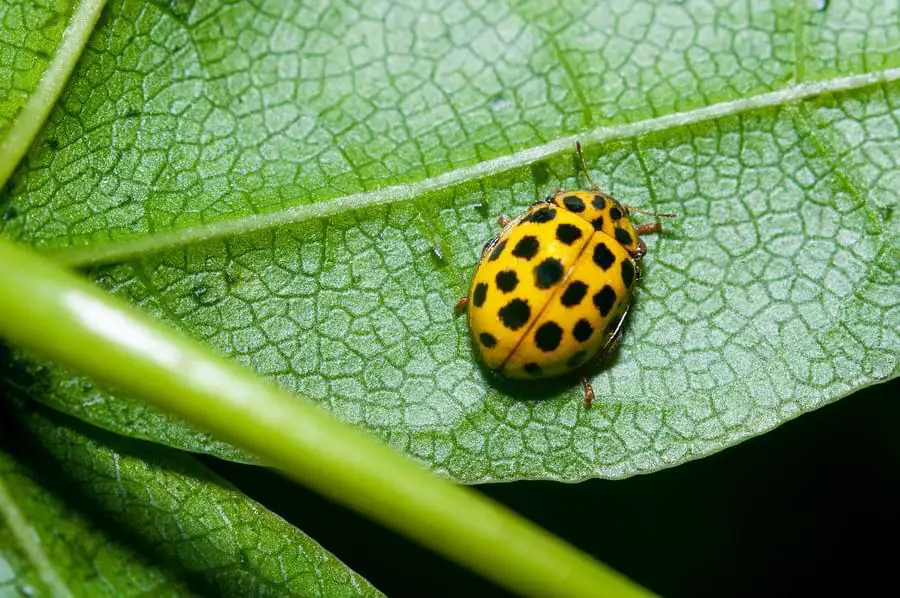Curious to know “do ladybugs sleep?” I’ve done some research and found some fascinating details about their sleeping habits. Let me share them with you.
Do Ladybugs Sleep?
Yes, ladybugs sleep, mostly at night. But they don’t close their eyes and fall asleep as we do. They enter a resting period, during which they remain still and unresponsive for hours. While ‘sleeping’, ladybugs tuck their legs under their shell and tuck their head into the pronotum for protection.
Do Ladybugs Sleep?
Still, there’s much more to this ‘sleeping’ topic of ladybugs that is fascinating. Let’s discuss it in a bit more detail.
When Ladybugs Sleep

Ladybugs sleep at night and are active during the day.
This is because, as cold-blooded creatures, ladybugs rely on external heat sources for warmth, which helps them stay active in order to hunt for the food they need each day.
And at night, like many creatures, they sleep and rest while continuing to digest and live off energy reserves acquired from the food they’ve collected throughout the day. Once the new day arrives they can absorb more warmth and begin the cycle again.
Also at night if it’s cold like in Winter, ladybugs often sleep in groups for warmth, this is why you can often see groups of them hibernating together. This time is known as diapause.
Did You Know…
A group of ladybugs is called a ‘Loveliness of Ladybugs’
Tell me more Interesting Facts about Ladybugs
Ladybugs do sleep (hibernate) of and on all winter. But during winter, ladybugs often migrate to other warmer regions or hibernate (sometimes in large groups). The hibernation period ends only during the early spring season.
Partly because when the weather turns cold (often once below 13F degrees), ladybugs are unable to fly and so cannot hunt for the food they need, plus in wintertime, food becomes more scarce anyway.

Where Ladybugs Sleep
Ladybugs can sleep just about anywhere, even where there’s a little warmth. They don’t specifically sleep in a ‘type’ of place but do prefer warmth away from any cold winds, frost, or snow.
The temperature reductions at night simply make ladybugs more inactive.
You will often find them ‘sleeping’ under tree bark, logs, bushes, cracks in trees and wood, dense vegetation, and ground cover.
Ladybugs will often sleep near a source of food. So you could easily find them resting near aphid colonies or around fruit plants. So when the morning arrives they’ll have breakfast ready and waiting for them.
You could even find them sleeping in your house, between your curtains, door or window frames, sheds, or even in your bed or under your pillow.
Did You
A number of things attract Ladybugs to our gardens and homes.
Find out What Attracts Ladybugs.
And if they invade your home, then here’s what to do.
Below are a couple of pictures I’ve taken of Ladybugs asleep, one I found dozing on a leaf, ready to wake up to more aphid snacks! The other curled up in a flower bed!

So check your own ‘bed’ thoroughly before you go to sleep, although ladybugs are not a threat to humans.
…And before you dust off this tiny cute critter from your bed, let’s look at how long it might have been there, or how many hours it might share your bed!
How Long Do Ladybugs Sleep For
Although how many hours ladybugs sleep is unknown exactly, they are diurnal, like humans and many other insects, so they will be active during the daytime, hunting, eating, flying, and doing what ladybugs do.
Then at night, they will find a safe spot that provides some cover and enough warmth in order to begin their rest period.
Ladybug eyesight is pretty good, mainly at short distances, but they do not have any night vision, so seeing at night is not an option for them anyway.

They never ‘sleep in’, the early morning daylight time is critical for them to refresh their energy by hunting, so they’ll set off at first light once they’ve warmed up enough.
But, if they’ve hunted enough food during the early part of the day, they may take a rest break in order to digest the food and gather their energy for further activities.
When ladybugs hibernate, they can remain in this constant state of ‘sleep’ or rather ‘rest’, until the temperature reaches around 13-15 degrees Fahrenheit.
This is the temperature at which sap begins to rise, leaves begin their growth and of course, aphids can begin moving around. Naturally then, this is the time ladybugs begin to come out of their cozy winter hidings to feed.

Do Ladybugs Sleep on Their Backs?
Although not confirmed at its best, generally speaking, ladybugs do not sleep on their backs with their feet sticking in the air.

The lack of protection would make them too vulnerable to predators, they would not adopt this pose voluntarily. In groups, they may be tipped over within the crowded space but will look to flip onto their feet.
The most likely case here is that they are dead or dying. Because when dying, a ladybug rolls into its back, through reduced coordination and a failing nervous system.
This weak state makes it difficult for the ladybug to turn itself right while dying. Find out how to tell for sure and what to do about it in my article ‘How To Tell if a Ladybug is Dead or Dying’.
But if ladybugs are asleep or even playing dead, they are able to flex their Elytra (outer shell wings) in order to turn themselves back the right way around. After which they carry on with their ladybug business.
Sometimes knowing these differences between sleeping, playing dead, and actually being dead can be confusing. So, I’ll talk you through some ways to know how a ladybug is asleep.
How To Know if a Ladybug is Asleep

Ladybugs are unresponsive and remain still when they’re ‘asleep’. Ladybugs love sunlight and everything warm, which is why they are active during the day.
So during the daytime, even the shadow that falls over them might disturb them. In such a situation they respond quicker by moving away, so try putting your hand between them and the sun, after a minute, they may move.
When they’re asleep, shining a flashlight on them will likely not see them move either if anything, they may like the warmth, or they might suspect a predator and play dead anyway.
So if you think a Ladybug is asleep, my advice is to leave it. As long as you know it’s in a safe place then let it rest.
If you really need to know if a ladybug is asleep, then turn it to its back and tickle or press very gently the head area. If it’s asleep or playing dead it will react and kick its legs about.
Or if you have the time, then leave the ladybug in a place you can observe it from, and check if it moves within the time. This might be quite a few hours.
And if there is still no response after trying any of the above, then it is more likely that the ladybug is dying or is already dead.
check out my Frequently Asked Questions page for more quick-fire answers
Do Ladybugs Sleep? – Conclusion
Ladybugs are diurnal, they do not sleep in the normal sense but will rest and tuck their head under their pronotum as well as bring in their legs under their protective shell.
They remain inactive at night, But, they don’t sleep for long hours during the day since they need to maintain an active eating regime.
Ladybugs can sleep anywhere, preferably with a little warmth, from stems, cracks of wood, sheds, door frames, and even curtains.
They also hibernate or migrate during the winter season until the early spring season. And they remain in hibernation until the temperature reaches around 13 degrees Fahrenheit.
At night when it’s cold or when hibernating during the winter they sleep in groups to maintain warmth.
I hope you’ve enjoyed this article. If you did then feel free to share it and/or comment. Also, be sure to check out my wonderful collection of Ladybug gifts and free resources.
Related Questions:
Can ladybugs damage your house? Yes, not intentionally, and no physical damage, but aside from the usual droppings, when Ladybugs are threatened or attacked, they emit a toxin known as ‘reflex bleeding’ This substance is known to leave staining on light called walls, ceilings, and other surfaces.



This was a lovely little article to read. I’m now confident that the ladybug on my bedside table (who now has a water soaked raisin and damp paper towel to wake up to) is happily sleeping the night away, as I will be in a few moments. Thanks!
How lovely x
I really liked this article except I wonder if the word nocturnal is used in the paper in the opposite sense to what it means
eg
“Although how many hours ladybug sleep is unknown exactly, they are nocturnal, like humans and many other insects, so they will be active during the daytime, hunting, eating, flying and doing what ladybugs do. Then at night, they will find a safe spot that provides some cover and enough warmth in order to begin their rest period.”
I think the word for active in the day and resting at night is “diurnal”. But i am not sure.
Thank you K, you are absolutely right of course, I’ve corrected the error. Thanks again for spotting that 🙂
What time do ladybugs wake up? How does a female ladybug find it’s guy?
Thank you for the comment Isaiah, they don’t sleep quite the way we do and tend to “wake” at daybreak. they find their guy by using pheromones. Think of it as Ladybug perfume! 🙂